brake Lexus IS250 2009 Specifications / LEXUS 2009 IS350/250 OWNER'S MANUAL (OM53669U)
[x] Cancel search | Manufacturer: LEXUS, Model Year: 2009, Model line: IS250, Model: Lexus IS250 2009Pages: 488, PDF Size: 6.24 MB
Page 3 of 488

1
2
3
4
5
6
7
3
Manual transmission .................... 137
Turn signal lever ............................ 139
Parking brake ................................. 140
Horn...................................................... 141
2-2. Instrument cluster Gauges and meters ..................... 142
Indicators and warning lights................................................. 148
Multi-information display............. 151
2-3. Operating the lights and windshield wipers
Headlight switch ............................ 156
Fog light switch .............................. 159
Windshield wipers and washer............................................. 160
Headlight cleaner switch ........... 165
2-4. Using other driving systems Cruise control ................................ 166
Dynamic radar cruise control............................................. 170
Intuitive parking assist ................. 180
Driving assist systems.................. 186
PCS (Pre-Collision System) ............ 192 2-5. Driving information
Cargo and luggage ...................... 196
Vehicle load limits ......................... 199
Winter driving tips ...................... 200
Trailer towing ................................. 204
Dinghy towing (vehicles with an automatic
transmission) .............................. 205
Dinghy towing (vehicles with a manual transmission) ........... 206
3-1. Using the air conditioning system and defogger
Automatic air conditioning system ............................................. 210
Rear window and outside rear view mirror defoggers ............. 218
3-2. Using the audio system Audio system type ........................ 219
Using the radio.............................. 222
Using the CD player................... 229
Playing back MP3 and WMA discs.................................. 235
Optimal use of the audio system ............................................. 241
Using the AUX adapter ............ 244
Using the steering wheel audio switches ............................ 245
3Interior features
Page 11 of 488
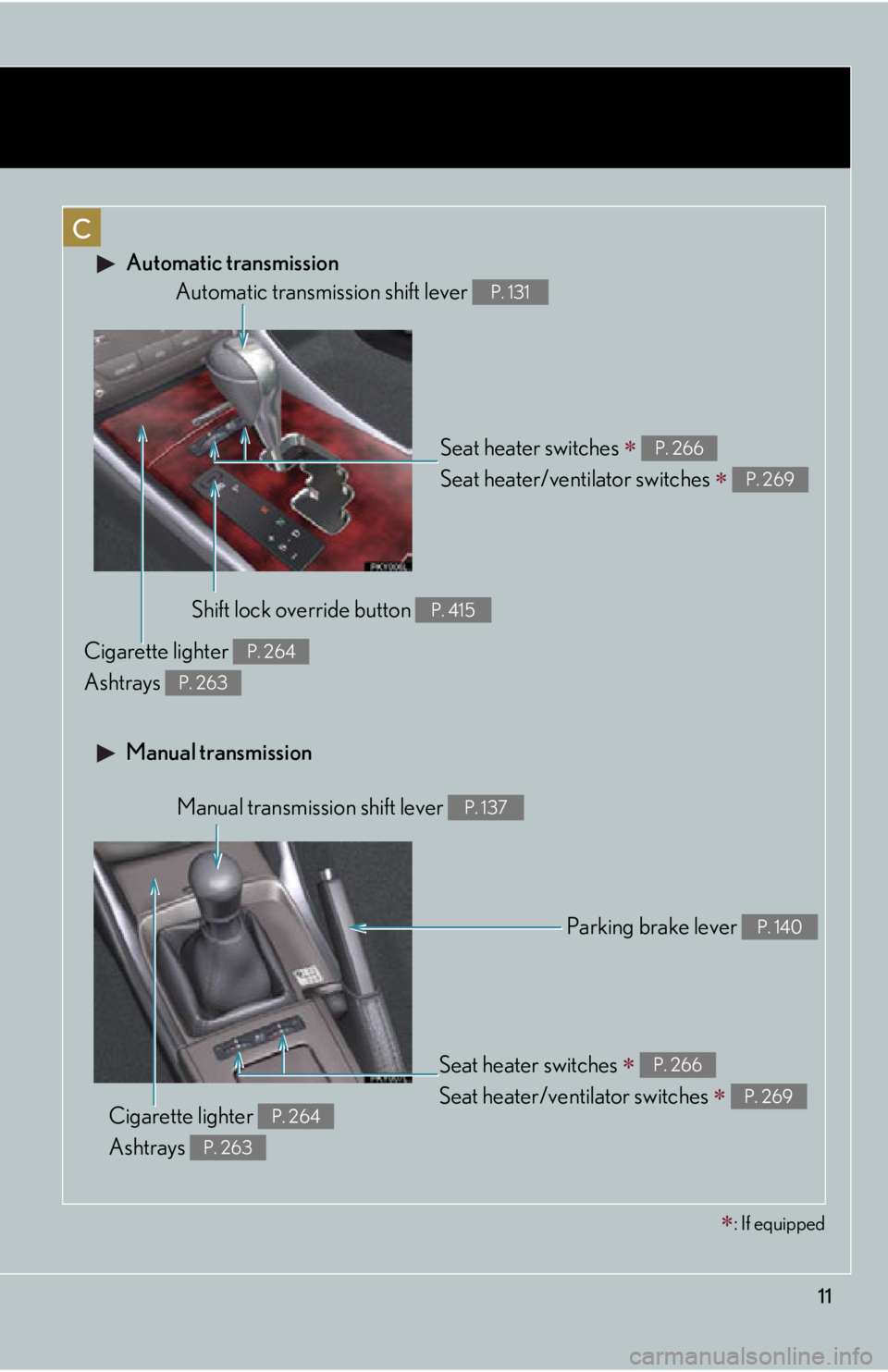
11
C
Automatic transmission
Manual transmission
Seat heater switches
Seat heater/ventilator switches
P. 266
P. 269
Automatic transmission shift lever P. 131
Shift lock override button P. 415
Cigarette lighter
Ashtrays P. 264
P. 263
Manual transmission shift lever P. 137
Parking brake lever P. 140
Cigarette lighter
Ashtrays P. 264
P. 263
Seat heater switches
Seat heater/ventilator switches
P. 266
P. 269
: If equipped
Page 12 of 488
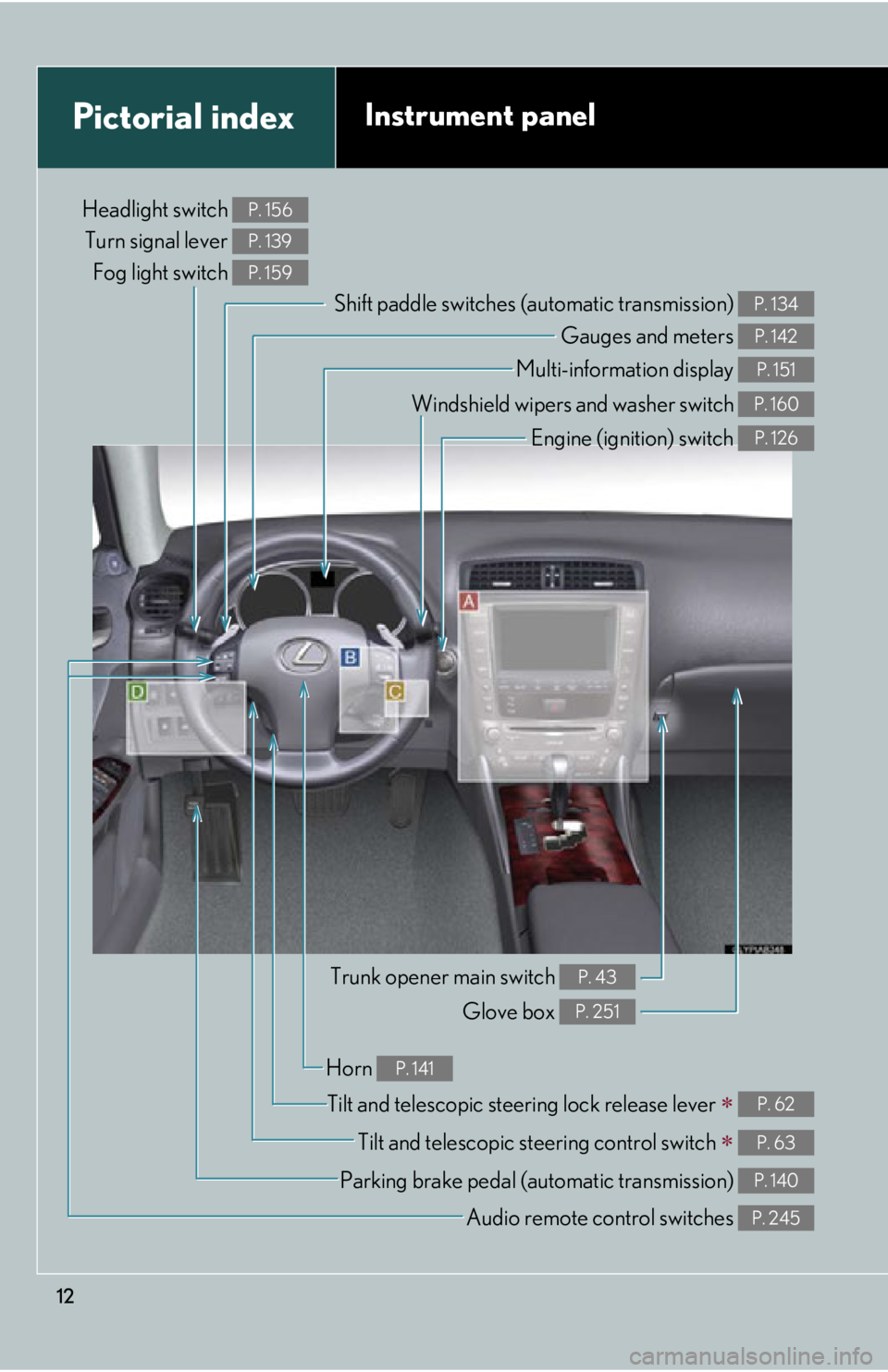
12
Pictorial indexInstrument panel
Headlight switch Turn signal lever Fog light switch P. 156
P. 139
P. 159
Shift paddle switches (automatic transmission) P. 134
Gauges and meters P. 142
Multi-information display P. 151
Windshield wipers and washer switch P. 160
Engine (ignition) switch P. 126
Trunk opener main switch P. 43
Glove box P. 251
Tilt and telescopic steering lock release lever P. 62
Tilt and telescopic steering control switch P. 63
Parking brake pedal (automatic transmission) P. 140
Audio remote control switches P. 245
Horn P. 141
Page 16 of 488

16
For your information
Main Owner’s Manual
Please note that this manual applies to all models and explains all equipment, includ-
ing options. Therefore, you may find some explanations for equipment not installed
on your vehicle.
All specifications provided in this manual are current at the time of printing. How-
ever, because of the Lexus policy of continual product improvement, we reserve the
right to make changes at any time without notice.
Depending on specifications, the vehicle sh own in the illustration may differ from
your vehicle in terms of color and equipment.
Accessories, spare parts and modification of your Lexus
A wide variety of non-genuine spare parts and accessories for Lexus vehicles are
currently available in the market. You should know that Toyota does not warrant
these products and is not responsible for their performance, repair, or replacement,
or for any damage they may cause to, or adverse effect they may have on, your
Lexus vehicle.
This vehicle should not be modified with non-genuine Lexus products. Modification
with non-genuine Lexus products could affect its performance, safety or durability,
and may even violate governmental regula tions. In addition, damage or perfor-
mance problems resulting from the modification may not be covered under war-
ranty.
Installation of a mobile two-way radio system
As the installation of a mobile two-way radio system in your vehicle could affect
electronic systems such as the multiport fuel injection system/sequential multiport
fuel injection system, cruise control syst em, anti-lock brake system, SRS airbag sys-
tem and seat belt pretensioner system, be sure to check with your Lexus dealer for
precautionary measures or special instructions regarding installation.
Page 48 of 488
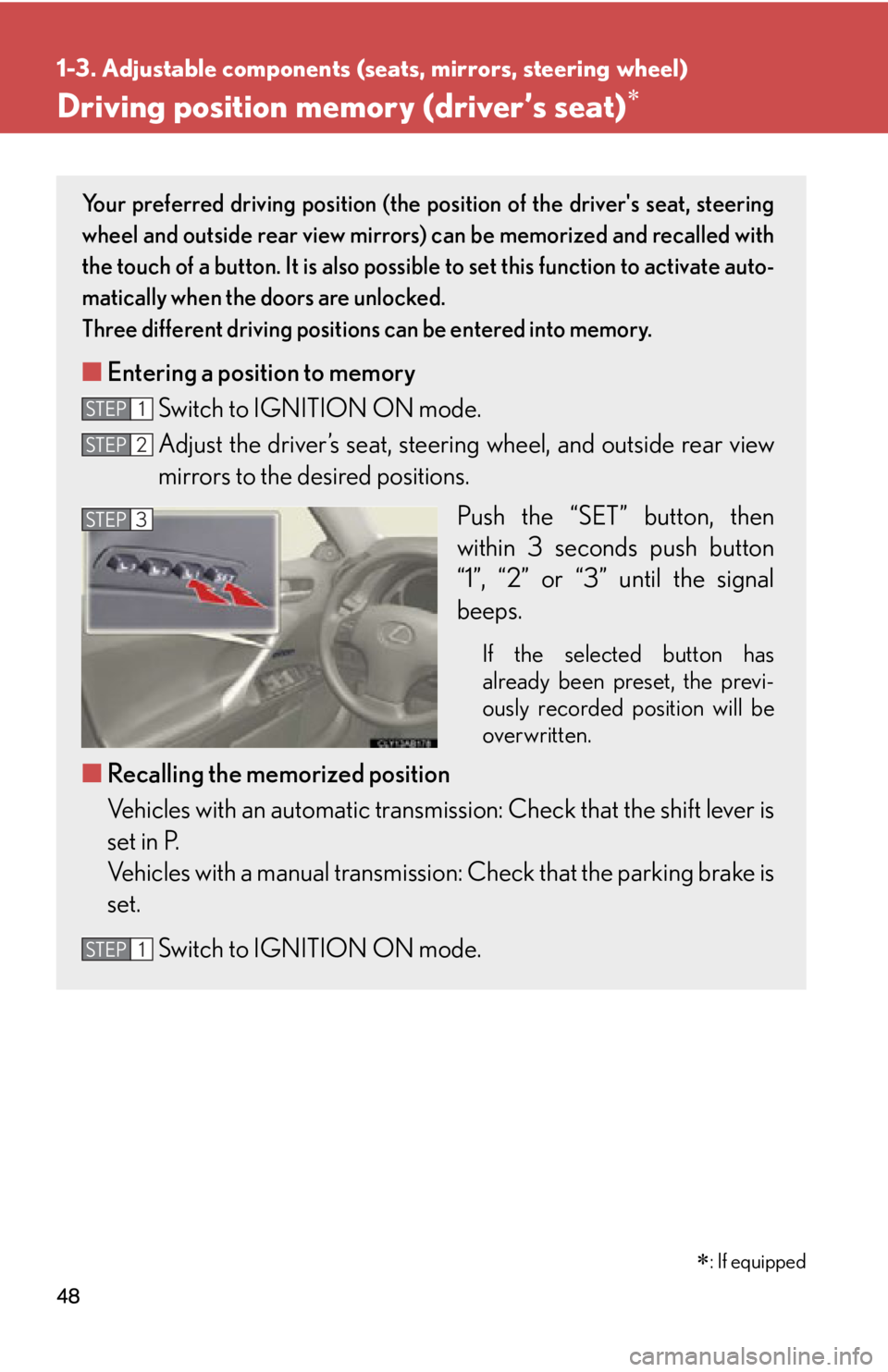
48
1-3. Adjustable components (seats, mirrors, steering wheel)
Driving position memory (driver’s seat)
Your preferred driving position (the position of the driver's seat, steering
wheel and outside rear view mirrors) can be memorized and recalled with
the touch of a button. It is also possible to set this function to activate auto-
matically when the doors are unlocked.
Three different driving positions can be entered into memory.
■ Entering a position to memory
Switch to IGNITION ON mode.
Adjust the driver’s seat, steeri ng wheel, and outside rear view
mirrors to the desired positions.
Push the “SET” button, then
within 3 seconds push button
“1”, “2” or “3” until the signal
beeps.
If the selected button has
already been preset, the previ-
ously recorded position will be
overwritten.
■Recalling the memorized position
Vehicles with an automatic transmis sion: Check that the shift lever is
set in P.
Vehicles with a manual transmissi on: Check that the parking brake is
set.
Switch to IGNITION ON mode.
STEP1
STEP2
STEP3
STEP1
�
: If equipped
Page 52 of 488
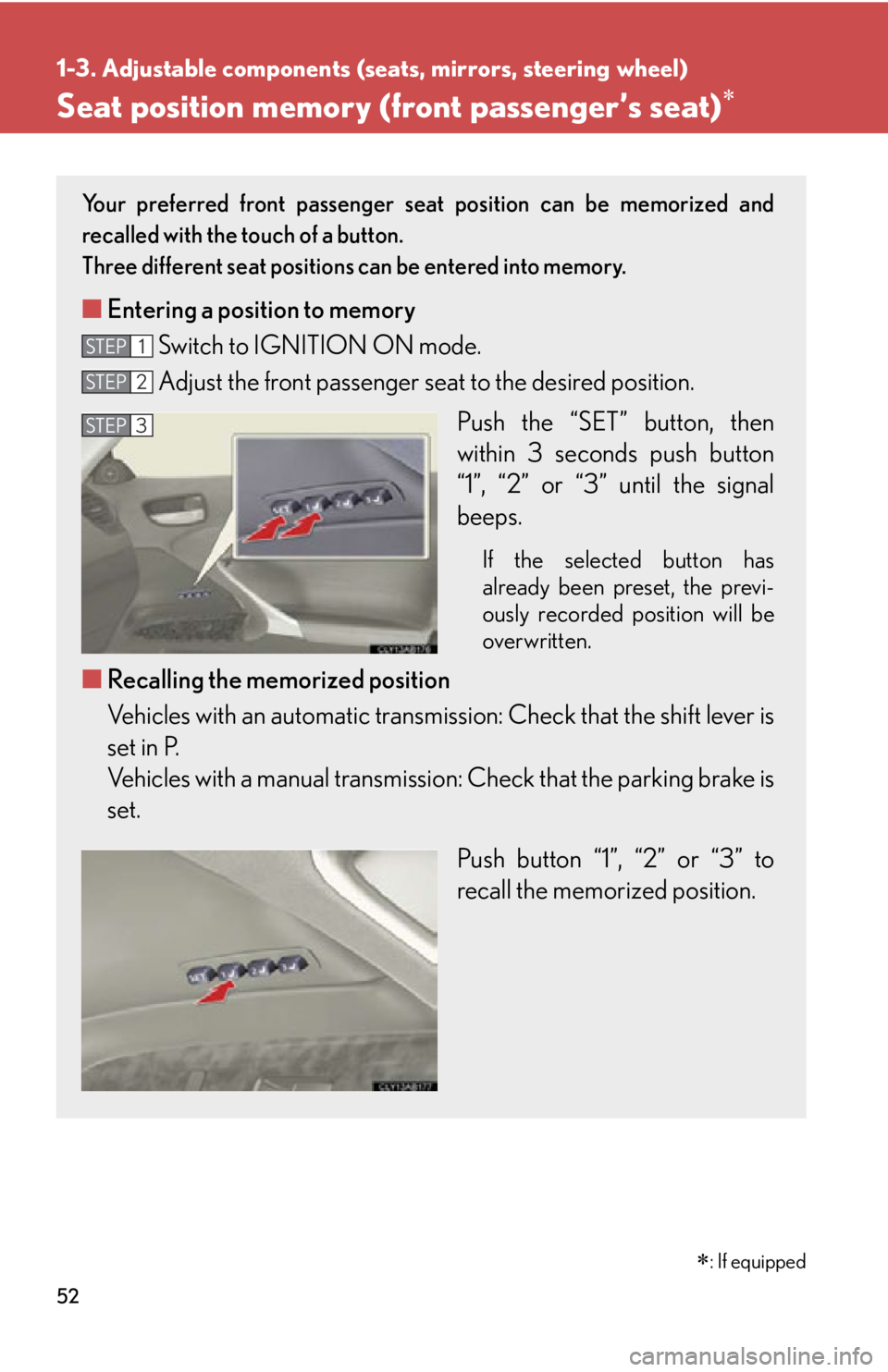
52
1-3. Adjustable components (seats, mirrors, steering wheel)
Seat position memory (front passenger’s seat)
Your preferred front passenger seat position can be memorized and
recalled with the touch of a button.
Three different seat positions can be entered into memory.
■Entering a position to memory
Switch to IGNITION ON mode.
Adjust the front passenger seat to the desired position.
Push the “SET” button, then
within 3 seconds push button
“1”, “2” or “3” until the signal
beeps.
If the selected button has
already been preset, the previ-
ously recorded position will be
overwritten.
■Recalling the memorized position
Vehicles with an automatic transmis sion: Check that the shift lever is
set in P.
Vehicles with a manual transmissi on: Check that the parking brake is
set.
Push button “1”, “2” or “3” to
recall the memorized position.
STEP1
STEP2
STEP3
�
: If equipped
Page 115 of 488
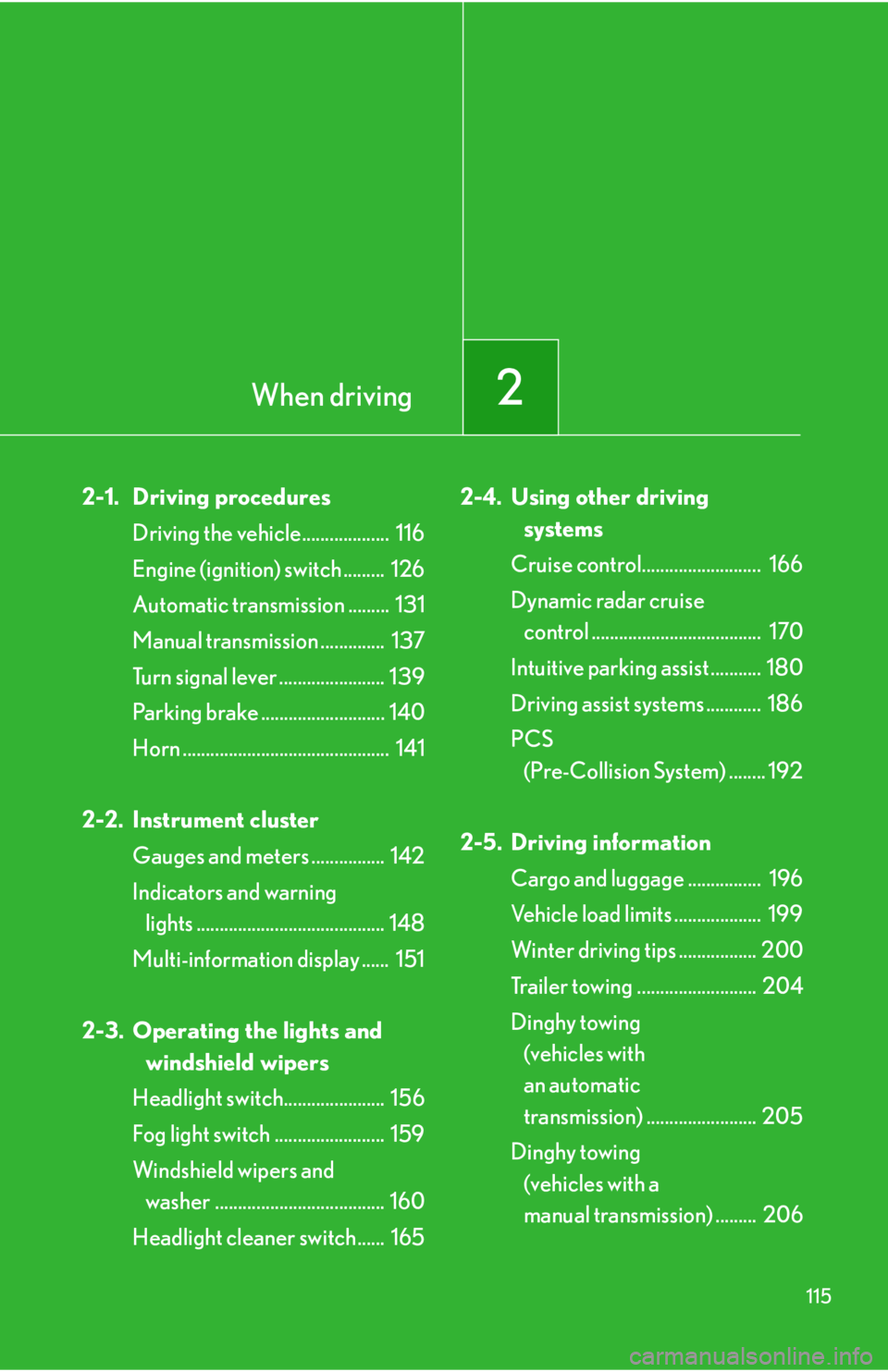
When driving2
115
2-1. Driving proceduresDriving the vehicle................... 116
Engine (ignition) switch ......... 126
Automatic transmission ......... 131
Manual transmission .............. 137
Turn signal lever ....................... 139
Parking brake ........................... 140
Horn ............................................. 141
2-2. Instrument cluster Gauges and meters ................ 142
Indicators and warning lights ......................................... 148
Multi-information display ...... 151
2-3. Operating the lights and windshield wipers
Headlight switch...................... 156
Fog light switch ........................ 159
Windshield wipers and washer ..................................... 160
Headlight cleaner switch...... 165 2-4. Using other driving
systems
Cruise control.......................... 166
Dynamic radar cruise control ..................................... 170
Intuitive parking assist ........... 180
Driving assist systems ............ 186
PCS (Pre-Collision System) ........ 192
2-5. Driving information Cargo and luggage ................ 196
Vehicle load limits ................... 199
Winter driving tips ................. 200
Trailer towing .......................... 204
Dinghy towing (vehicles with
an automatic
transmission) ........................ 205
Dinghy towing (vehicles with a
manual transmission) ......... 206
Page 116 of 488
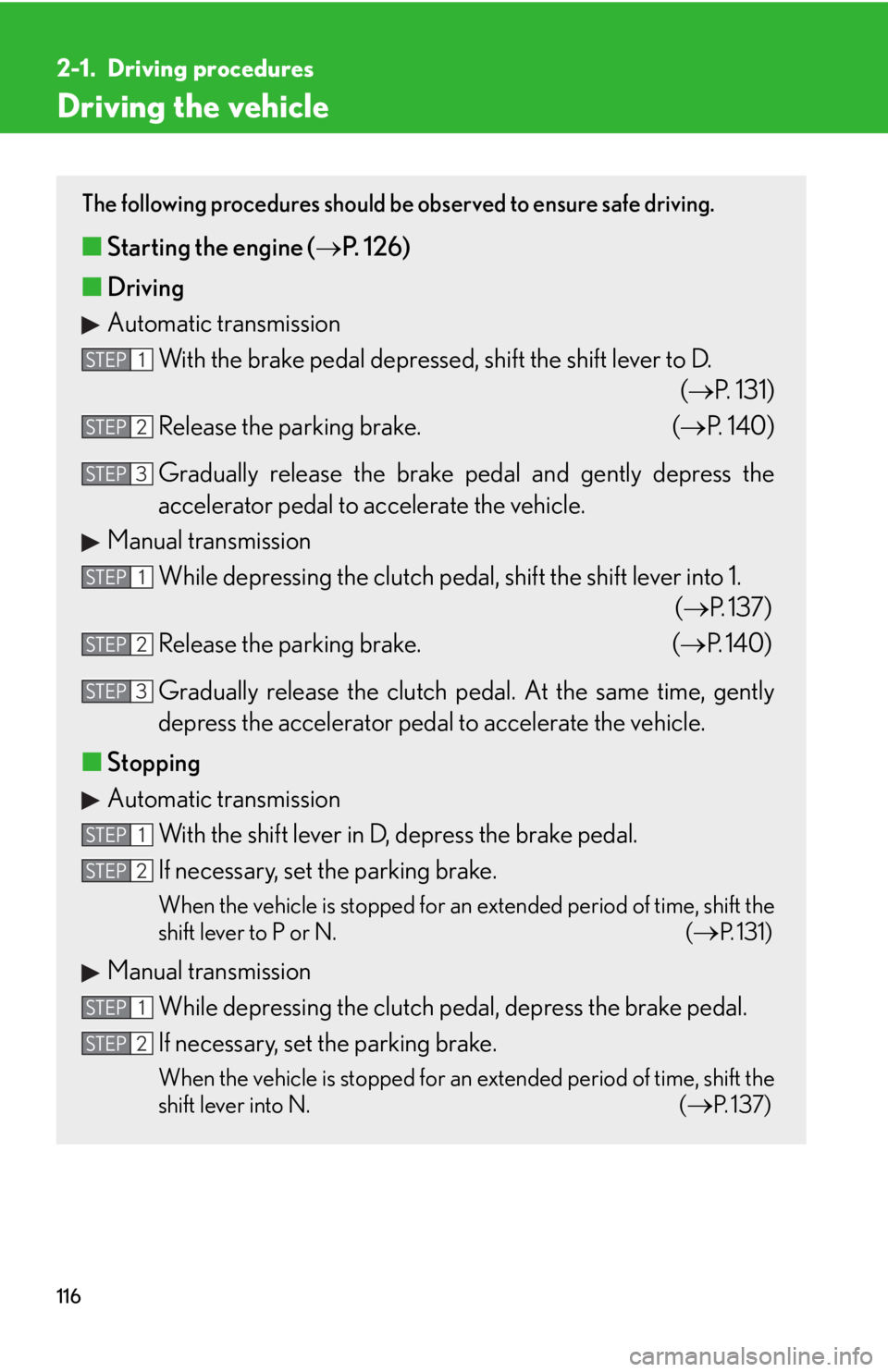
116
2-1. Driving procedures
Driving the vehicle
The following procedures should be observed to ensure safe driving.
■Starting the engine ( P. 126)
■ Driving
Automatic transmission
With the brake pedal depressed, shift the shift lever to D. (P. 1 3 1 )
Release the parking brake. ( P. 140)
Gradually release the brake pedal and gently depress the
accelerator pedal to accelerate the vehicle.
Manual transmission
While depressing the clutch pedal, shift the shift lever into 1. (P. 1 3 7 )
Release the parking brake. ( P. 140)
Gradually release the clutch pedal. At the same time, gently
depress the accelerator pedal to accelerate the vehicle.
■ Stopping
Automatic transmission
With the shift lever in D, depress the brake pedal.
If necessary, set the parking brake.
When the vehicle is stopped for an extended period of time, shift the
shift lever to P or N. (
P. 131)
Manual transmissionWhile depressing the clutch pedal, depress the brake pedal.
If necessary, set the parking brake.
When the vehicle is stopped for an extended period of time, shift the
shift lever into N. (
P. 1 3 7 )
STEP1
STEP2
STEP3
STEP1
STEP2
STEP3
STEP1
STEP2
STEP1
STEP2
Page 117 of 488
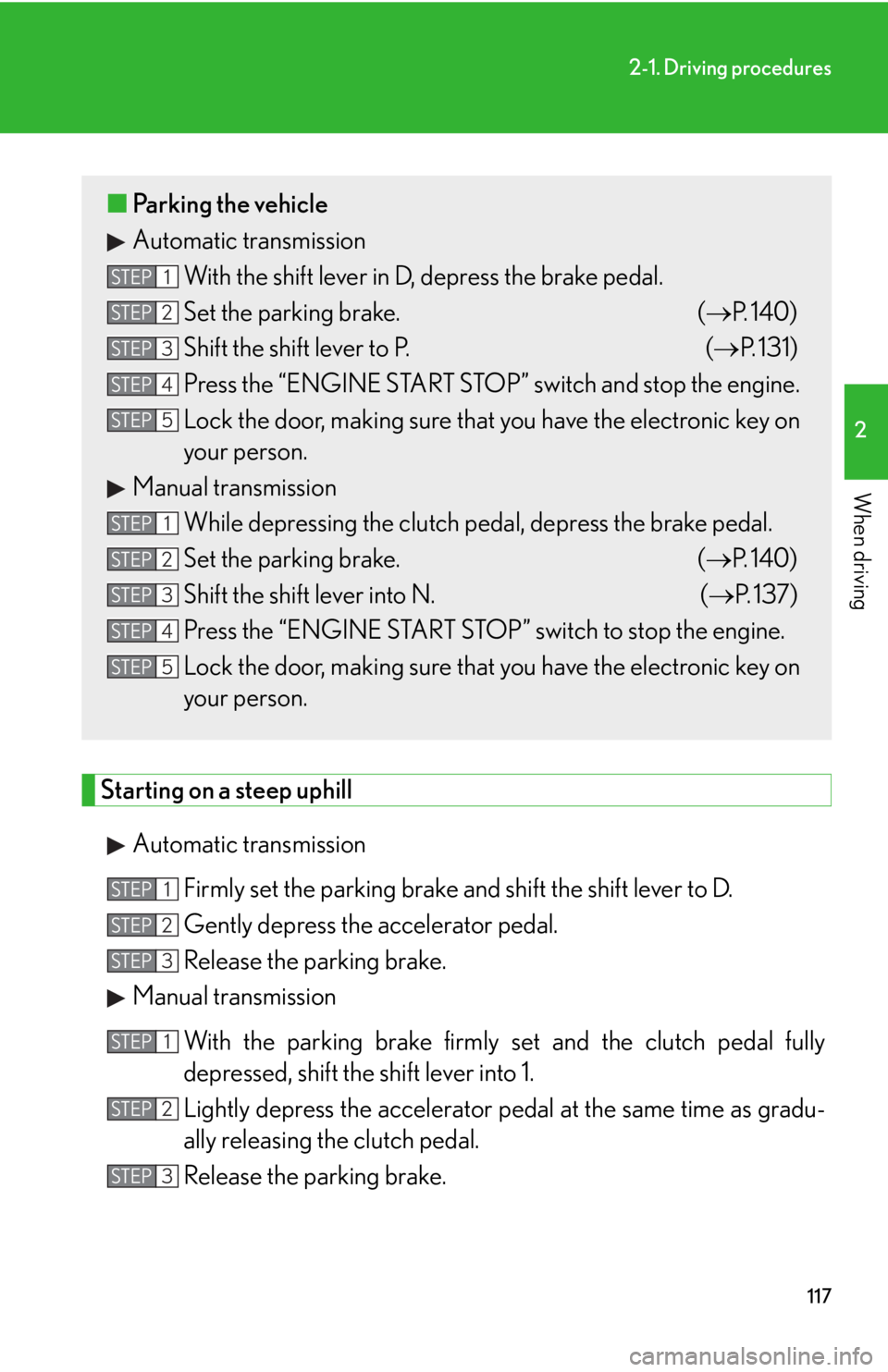
117
2-1. Driving procedures
2
When driving
Starting on a steep uphillAutomatic transmission Firmly set the parking brake and shift the shift lever to D.
Gently depress the accelerator pedal.
Release the parking brake.
Manual transmission
With the parking brake firmly set and the clutch pedal fully
depressed, shift the shift lever into 1.
Lightly depress the accelerator pedal at the same time as gradu-
ally releasing the clutch pedal.
Release the parking brake.
■ Parking the vehicle
Automatic transmission
With the shift lever in D, depress the brake pedal.
Set the parking brake. ( P. 140)
Shift the shift lever to P. ( P. 1 3 1 )
Press the “ENGINE START STOP” switch and stop the engine.
Lock the door, making sure that you have the electronic key on
your person.
Manual transmission While depressing the clutch pedal, depress the brake pedal.
Set the parking brake. ( P. 140)
Shift the shift lever into N. ( P. 1 3 7 )
Press the “ENGINE START STOP” switch to stop the engine.
Lock the door, making sure that you have the electronic key on
your person.
STEP1
STEP2
STEP3
STEP4
STEP5
STEP1
STEP2
STEP3
STEP4
STEP5
STEP1
STEP2
STEP3
STEP1
STEP2
STEP3
Page 118 of 488

118
2-1. Driving procedures
■Starting off on a hill (vehicles with an automatic transmission)
Hill-start assist control will operate. (P. 1 8 6 )
■Driving in the rain
●Drive carefully when it is raining, because visibility will be reduced, the windows
may become fogged-up, and the road will be slippery.
●Drive carefully when it starts to rain, because the road surface will be especially
slippery.
●Refrain from high speeds when driving on an expressway in the rain, because
there may be a layer of water between th e tires and the road surface, preventing
the steering and brakes from operating properly.
■Breaking in your new Lexus
To extend the life of the vehicle, the following precautions are recommended to
observe:
●For the first 186 miles (300 km):
Avoid sudden stops.
●For the first 621 miles (1000 km):
• Do not drive at extremely high speeds.
• Avoid sudden acceleration.
• Do not drive continuously in the low gears.
• Do not drive at a constant speed for extended periods.
■Drum-in-disc type parking brake system
Your vehicle has a drum-in-disc type parking brake system. This type of brake sys-
tem needs bedding-down of the brake shoe s periodically or whenever the parking
brake shoes and/or drum are replaced. Have your Lexus dealer perform the bed-
ding down.
■Operating your vehicle in a foreign country
Comply with the relevant vehicle registration laws and confirm the availability of the
correct fuel. ( P. 4 3 3 )
■Normal characteristics after turning off the engine
Approximately five hours after the engine is turned off, you may hear sound coming
from under the vehicle for several minutes. This is because fuel evaporation leakage
check is performed. It does not indicate a malfunction.